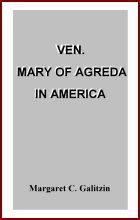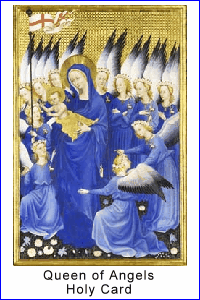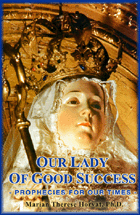Symbolism
 |
 |
 |
 |
 |
 |
 |
The Symbolism of the Peacock
Seeing the beautiful background of peacock feathers on the entrance to the Our Lady of Good Success page, I began to wonder about the symbolism of that majestic bird. I have also seen the peacock on art works in medieval paintings and manuscripts and used in decorative motifs on churches and buildings. The peacock even appears among the animals in the stable in Christ's nativity. This made me wonder what it represented to the medieval world. Certainly it signified something more than pride, as in the modern maxim, “proud as a peacock.”
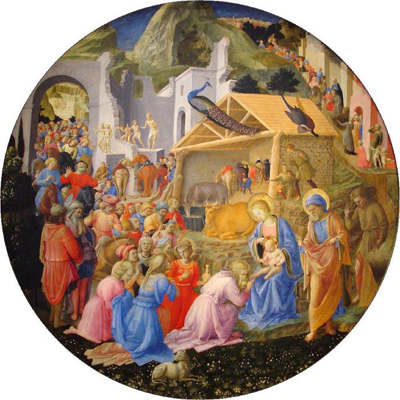
Peacocks on the stable rooftop
in a Fra Angelico nativity scene
As readers of this site undoubtedly know, for medieval man everything in nature had a significance that related to God’s purpose for the universe. So, I was not surprised to find a wide gamut of rich symbolic meanings for the peacock.
Catholics adopted the symbol of the peacock to represent resurrection, renewal and immortality. This came from the ancient legend that the flesh of the peacock did not decay. Thus we find paintings and mosaics with the peacock as early as the 3rd century on the walls of the catacombs of Rome, a symbol of the exchanging of the mortal earthly body for the glorified body and eternal life of the glorified soul in Heaven.
Also the medieval bestiaries tell us that the peacock sheds its old feathers every year and grows newer, more brilliant ones each year, a sign of renewal, and the feathers were used to decorate churches at Easter and Christmas. You can also find the peacock in many mosaics and images in baptisteries of ancient Catholic churches in the East and West.
Because of this belief that the peacock’s flesh did not decay after death, the peacock became a symbol of Christ, and, as such, early Christian paintings and mosaics use peacock imagery. When the peacock displays its tail, it looks like hundreds of eyes are watching us. Because of this, the peacock has been associated with the all-seeing eye of God Who sees all actions and all people, meaning that nothing escapes the universal Justice. The peacock also came to symbolize the all-seeing Catholic Church, who watches over her children continually, day and night.
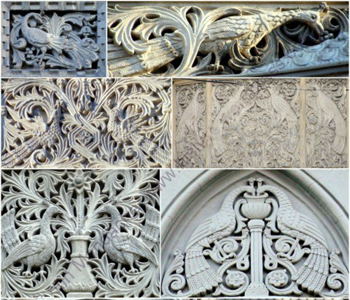
Peacocks were common decorative motifs on old churches and buildingss
The eyes of the peacock feathers also symbolize the beatific vision, the direct perception and knowledge of God as He truly is, enjoyed by Angels, Christ, and the Saints in Heaven, which was another reason it was a decorative motif on medieval tomb sculptures.
The peacock is a destroyer of serpents and the bestiaries tell us it could swallow the poisonous venom without harm. It then used the poisons it swallowed to create its colorful plumage. For this reason, its blood was believed to dispel evil spirits, and its feathers and meat to cure snake-bite and sickness. St. Augustine affirms this belief of the antiseptic qualities of the peacock flesh in The City of God:
“For who but God the Creator of all things has given to the flesh of the peacock its antiseptic property? This property, when I first heard of it, seemed to me incredible; but it happened at Carthage that a bird of this kind was cooked and served up to me, and, taking a suitable slice of flesh from its breast, I ordered it to be kept, and when it had been kept as many days as make any other flesh stinking, it was produced and set before me, and emitted no offensive smell. And after it had been laid by for thirty days and more, it was still in the same state; and a year after, the same still, except that it was a little more shriveled, and drier.” (Book 21, chapter 4):
Peacocks are also known to eat poisonous plants with no ill effects, another reason why their feathers are a symbol of incorruptibility and immortality.
Moral and allegorical lessons
The Aberdeen Bestiary offers moral and allegorical lessons about the exotically beautiful bird. It explains that the pride of the peacock became a lesson for the Catholic who strives for perfection.
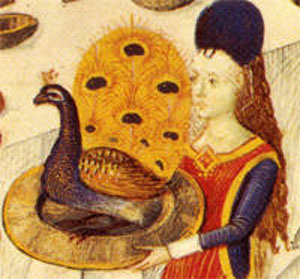
A roasted peacock dressed with its feathers at a medieval banquet
The early Christians believed that the peacock was offended by its ugly feet. So much so, that he would stop in his vain strutting and shriek angrily whenever he caught a glimpse of this blemish in his otherwise beautiful and dignified appearance. The lesson learned from the peacock in early bestiaries was that Christians ought also to lament and hate their own spiritual imperfections.
And the peacock’s flesh, voice and eyes also had lessons for man: “The hard flesh of the peacock represents the minds of teachers, who remain unaffected by the flames of lust. The fearful voice of the peacock is like the voice of the preacher who warns sinners of their end in Hell. The "eyes" on the peacock's tail are to signify the ability of the teachers to foresee the danger we all face in the end. The raising of the peacock's tail when it is praised should remind us to not let pride from praise affect us, so we do not expose our ugly vanity.”
I believe that reflections like these on symbolism invite us to view nature and all Creation as the medieval man did, seeking to find God’s mark and lessons in every living creature and thing.
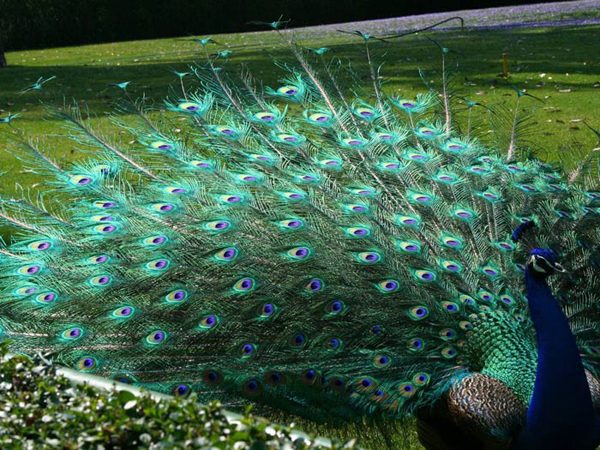
The eyes in the peacock tail represent the all-seeing eye of God and of Holy Mother Church
photo by Grace Hocker/Guide Your Pet


Peacocks on the stable rooftop
in a Fra Angelico nativity scene
Catholics adopted the symbol of the peacock to represent resurrection, renewal and immortality. This came from the ancient legend that the flesh of the peacock did not decay. Thus we find paintings and mosaics with the peacock as early as the 3rd century on the walls of the catacombs of Rome, a symbol of the exchanging of the mortal earthly body for the glorified body and eternal life of the glorified soul in Heaven.
Also the medieval bestiaries tell us that the peacock sheds its old feathers every year and grows newer, more brilliant ones each year, a sign of renewal, and the feathers were used to decorate churches at Easter and Christmas. You can also find the peacock in many mosaics and images in baptisteries of ancient Catholic churches in the East and West.
Because of this belief that the peacock’s flesh did not decay after death, the peacock became a symbol of Christ, and, as such, early Christian paintings and mosaics use peacock imagery. When the peacock displays its tail, it looks like hundreds of eyes are watching us. Because of this, the peacock has been associated with the all-seeing eye of God Who sees all actions and all people, meaning that nothing escapes the universal Justice. The peacock also came to symbolize the all-seeing Catholic Church, who watches over her children continually, day and night.

Peacocks were common decorative motifs on old churches and buildingss
The peacock is a destroyer of serpents and the bestiaries tell us it could swallow the poisonous venom without harm. It then used the poisons it swallowed to create its colorful plumage. For this reason, its blood was believed to dispel evil spirits, and its feathers and meat to cure snake-bite and sickness. St. Augustine affirms this belief of the antiseptic qualities of the peacock flesh in The City of God:
“For who but God the Creator of all things has given to the flesh of the peacock its antiseptic property? This property, when I first heard of it, seemed to me incredible; but it happened at Carthage that a bird of this kind was cooked and served up to me, and, taking a suitable slice of flesh from its breast, I ordered it to be kept, and when it had been kept as many days as make any other flesh stinking, it was produced and set before me, and emitted no offensive smell. And after it had been laid by for thirty days and more, it was still in the same state; and a year after, the same still, except that it was a little more shriveled, and drier.” (Book 21, chapter 4):
Peacocks are also known to eat poisonous plants with no ill effects, another reason why their feathers are a symbol of incorruptibility and immortality.
Moral and allegorical lessons
The Aberdeen Bestiary offers moral and allegorical lessons about the exotically beautiful bird. It explains that the pride of the peacock became a lesson for the Catholic who strives for perfection.

A roasted peacock dressed with its feathers at a medieval banquet
And the peacock’s flesh, voice and eyes also had lessons for man: “The hard flesh of the peacock represents the minds of teachers, who remain unaffected by the flames of lust. The fearful voice of the peacock is like the voice of the preacher who warns sinners of their end in Hell. The "eyes" on the peacock's tail are to signify the ability of the teachers to foresee the danger we all face in the end. The raising of the peacock's tail when it is praised should remind us to not let pride from praise affect us, so we do not expose our ugly vanity.”
I believe that reflections like these on symbolism invite us to view nature and all Creation as the medieval man did, seeking to find God’s mark and lessons in every living creature and thing.

The eyes in the peacock tail represent the all-seeing eye of God and of Holy Mother Church
photo by Grace Hocker/Guide Your Pet

Posted December 15, 2012
______________________
______________________



